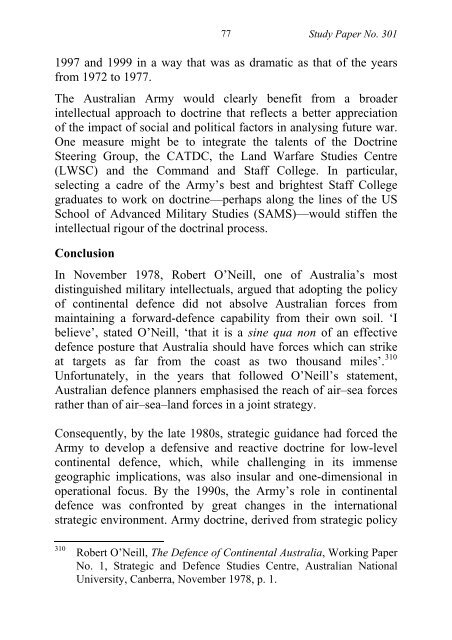Ibid - Australian Army
Ibid - Australian Army
Ibid - Australian Army
Create successful ePaper yourself
Turn your PDF publications into a flip-book with our unique Google optimized e-Paper software.
77<br />
Study Paper No. 301<br />
1997 and 1999 in a way that was as dramatic as that of the years<br />
from 1972 to 1977.<br />
The <strong>Australian</strong> <strong>Army</strong> would clearly benefit from a broader<br />
intellectual approach to doctrine that reflects a better appreciation<br />
of the impact of social and political factors in analysing future war.<br />
One measure might be to integrate the talents of the Doctrine<br />
Steering Group, the CATDC, the Land Warfare Studies Centre<br />
(LWSC) and the Command and Staff College. In particular,<br />
selecting a cadre of the <strong>Army</strong>’s best and brightest Staff College<br />
graduates to work on doctrine—perhaps along the lines of the US<br />
School of Advanced Military Studies (SAMS)—would stiffen the<br />
intellectual rigour of the doctrinal process.<br />
Conclusion<br />
In November 1978, Robert O’Neill, one of Australia’s most<br />
distinguished military intellectuals, argued that adopting the policy<br />
of continental defence did not absolve <strong>Australian</strong> forces from<br />
maintaining a forward-defence capability from their own soil. ‘I<br />
believe’, stated O’Neill, ‘that it is a sine qua non of an effective<br />
defence posture that Australia should have forces which can strike<br />
at targets as far from the coast as two thousand miles’. 310<br />
Unfortunately, in the years that followed O’Neill’s statement,<br />
<strong>Australian</strong> defence planners emphasised the reach of air–sea forces<br />
rather than of air–sea–land forces in a joint strategy.<br />
Consequently, by the late 1980s, strategic guidance had forced the<br />
<strong>Army</strong> to develop a defensive and reactive doctrine for low-level<br />
continental defence, which, while challenging in its immense<br />
geographic implications, was also insular and one-dimensional in<br />
operational focus. By the 1990s, the <strong>Army</strong>’s role in continental<br />
defence was confronted by great changes in the international<br />
strategic environment. <strong>Army</strong> doctrine, derived from strategic policy<br />
310<br />
Robert O’Neill, The Defence of Continental Australia, Working Paper<br />
No. 1, Strategic and Defence Studies Centre, <strong>Australian</strong> National<br />
University, Canberra, November 1978, p. 1.

















